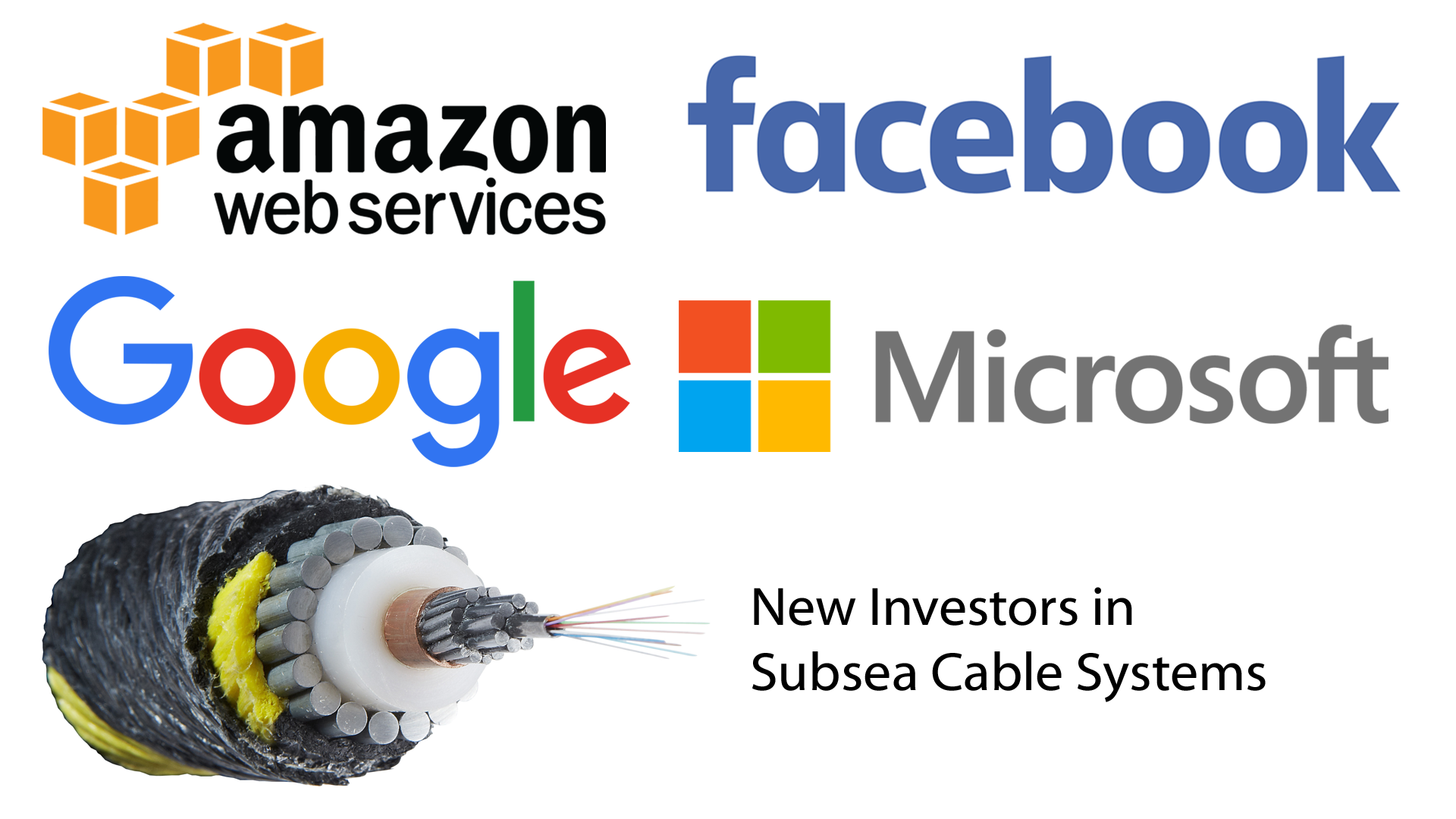According to TeleGeography data in May 2016, two-thirds of all traffic on transatlantic cables were from private networks, or networks run by companies for their own data transmission, and not telecommunications companies. That was up from 20% in 2010. The trend will not stop here with, e.g., the launch in early 2018 of the new MAREA cable system between USA and Spain where both Facebook and Microsoft have a significant share. In May 2016 there were about 337 Tbit/s of potential capacity across the Atlantic; the MAREA cable is designed to add another 160 Tbit/s!
This evolution is valid in other parts of the world as well, with demand for bandwidth shifting from traditional telecommunications companies to large content providers. Their need for bandwidth is growing so rapidly that it makes more and more economic sense for content providers to invest in their own infrastructure, whether entire subsea cables or fiber pairs in cables built with co-investors with similar connectivity needs and operational philosophy.

List of Public Investments by Content Providers into Subsea Cable Systems
Google was secret for a long time before unveiling their investment in subsea cable systems; today, Google either has invested or plans to invest in six undersea cables (based on public data). Facebook and Microsoft started shortly after. More recently (May 2016) Amazon Web Services announced their first investment in a transpacific subsea cable system.
Google has publicly announced ownership
stake in 6 subsea cable systems:
- Unity, 9,620 km cable connecting Japan and USA
(Put in service in 2010) - South-East Asia Japan Cable System (SJC), 8,900 km cable connecting Thailand, Singapore, Brunei, Philippines, Hong Kong, China and Japan (Put in service in June 2013)
- FASTER, 11,629 cable connecting Taiwan, Japan and USA (Put in service in June 2016)
- Monet, 10,556 km cable connecting Brazil and USA (Planned to be put in service in 2017)
- Tannat, 2,000 km cable connecting Uruguay and Brazil (Planned to be put in service in Q4 2017)
- Pacific Light Cable Network (PLCN), 12,800 km cable connecting Hong Kong and USA – With Facebook (Planned to be put in service in May 2018)
Microsoft is investor or foundational customer
in 5 subsea cable systems:
- Hibernia Express, 4,600 km cable connecting Canada, Ireland and UK (Put in service in September 2015)
- AEConnect (Aqua Comms), 5,522 km cable connecting USA and Ireland – Foundation customer (Put in service in January 2016)
- Seabras-1 (Seaborn Networks), 10,900 km cable connecting Brazil and USA – Foundation customer (Planned to be put in service in June 2017)
- New Cross Pacific (NCP), 13,618 km cable connecting Taiwan, China, South Korea, Japan and USA (Planned to be put in service in Q4 2017)
- MAREA, 6,600 km cable connecting the USA and Spain – With Facebook (Planned to be put in service in Q1 2018)
Facebook has publicly announced ownership stake
in 2 subsea cable systems:
- MAREA, 6,600 km cable connecting the USA and Spain – With Microsoft (Planned to be put in service in Q1 2018)
- Pacific Light Cable Network (PLCN), 12,800 km cable connecting Hong Kong and USA – With Google (Planned to be put in service in May 2018)
Amazon Web Services was a key customer completing
the financing round and enabling the effective launch
of one new cable construction:
- Hawaiki Cable, 10,200 km cable connecting Australia, New Zealand, American Samoa and USA (Planned to be put in service in Q2 2018)
And those above are only the publicly announced deals. One member of the GAFA team is missing in the list above and one can easily imagine that additional big names working at developing cloud-based and XaaS services are likely to be more active in the building of new subsea cable systems in the near future.
Additional New Players
In addition to these content providers who are new players for the subsea transport infrastructure, there are also new parties getting into the subsea industry. One quite visible example is Equinix, a provider of provider of carrier-neutral data centers and internet exchanges. Equinix plan is to be closely connected to subsea cable systems, for instance by terminating traffic directly in data centers, in line with the current evolution in interconnection between subsea cable systems and data centers as already discussed in previous posts (here, here and here). A press release, issued by Equinix on 12 September 2016, listed the current submarine cable projects that Equinix is engaged with and has publicly announced. This list includes: Southern Cross Cable Network (California – Sydney), Aqua Comms (New York – London), Hibernia Express (New York – London), Cinia C-Lion1 (Germany – Finland), Trident (Australia – Indonesia – Singapore), GlobeNet (Florida – Brazil), Asia Pacific Gateway (China – Hong Kong – Japan – South Korea – Malaysia – Taiwan – Thailand – Vietnam – Singapore), Hawaiki Cable Limited (U.S. – Australia – New Zealand), Gulf Bridge International (Middle East – Europe), FASTER (U.S. West Coast – Japan), Seaborn Networks (New York – Sao Paulo), and Monet (Florida – Brazil).

With the advent of all these new players (driven by the nature and volume of the predominant and fastest growing traffic), one basic question arises: what will be the weight of telecommunications companies in subsea industry in the midterm? Ten years ago, telcos were the game masters when it came to design and build new subsea cable systems but, clearly, the game is now changing.
For comments or questions, please contact us.

